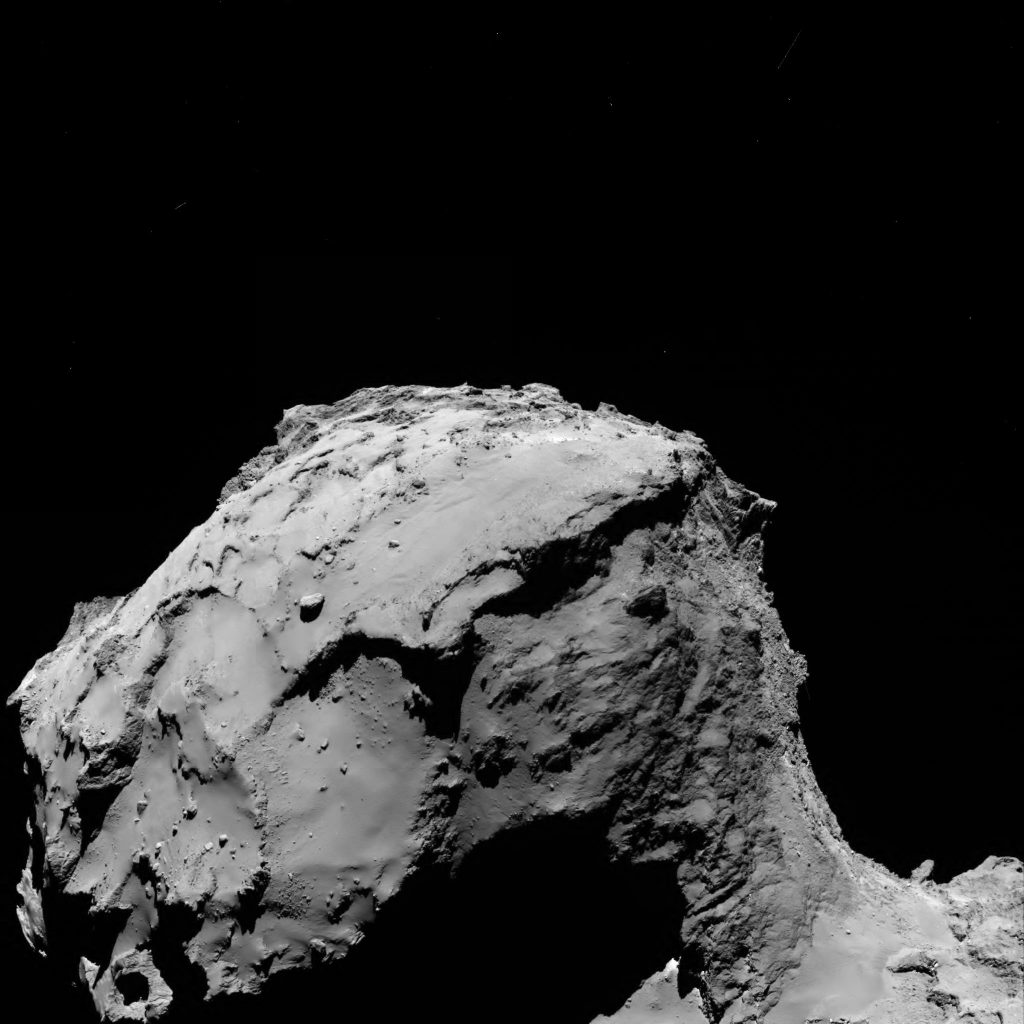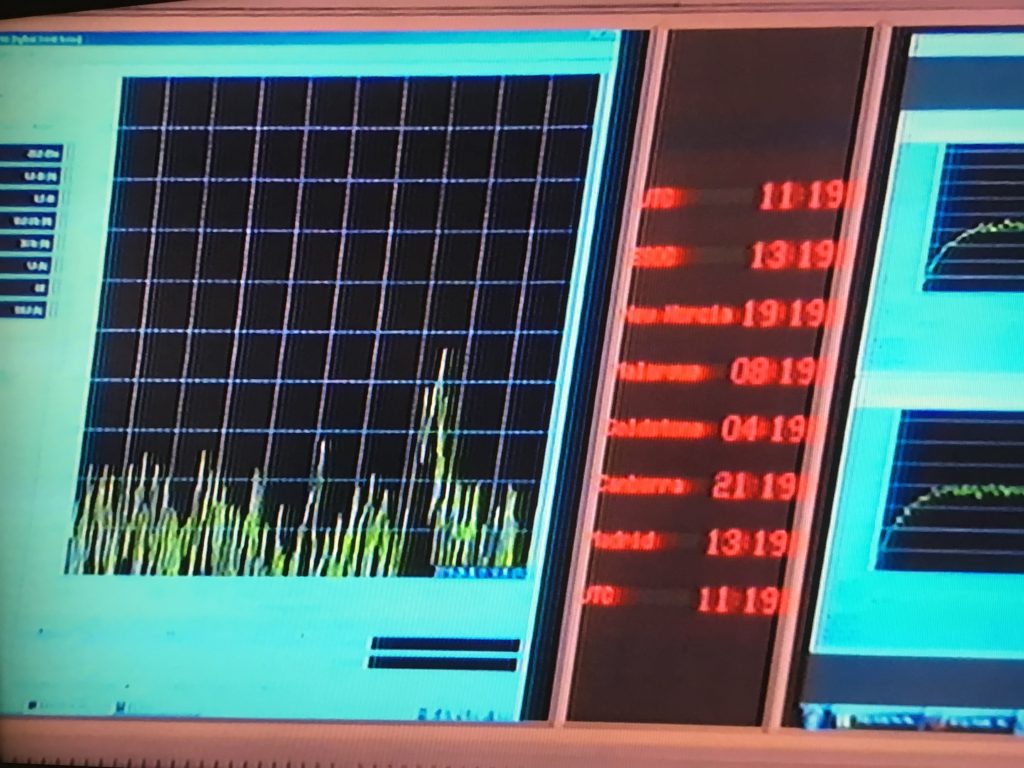30.09.2016
-
IMPACT TIME UPDATE: 10:38 UT
Based on the Navigation Camera images taken shortly after last night's collision manoeuvre, flight dynamics analysis has refined the predicted time of Rosetta's impact into the Ma'at region on the small lobe of Comet 67P/C-G to 10:38:32 UT+/- 2 minutes at the comet.
Because of the 40 minute signal travel time between Rosetta and the Earth today, confirmation of the mission's end will arrive at ESA's mission control at 11:18 UT/ 13:18 CEST +/- 2 minutes.
---
ROSETTA’S LAST NAVCAM IMAGE
Rosetta's Navigation Camera captured five images shortly after the collision manoeuvre last night, which are being analysed by flight dynamics to confirm the spacecraft is on track to impact its target in the Ma'at region of Comet 67P/C-G later today.
The last image returned from the spacecraft was taken at 00:59 UT onboard the spacecraft, and downlinked to Earth a couple of hours later. It was taken at a distance of 17.4 km from the centre of the comet. The image scale is 1.5m/pixel and the image measures about 1.5 km across.

Lightly enhanced NAVCAM image taken on 30 September 2016 at 00:59UT. ESA/Rosetta/NAVCAM – CC BY-SA IGO 3.0
The five images were used by the flight team to update the estimate of the landing time and final pointing of the spacecraft. The revised impact time is now predicted as 10:38:32 UT+/- 2 minutes at the comet.Because of the 40 minute signal travel time between Rosetta and the Earth today, confirmation of the mission's end will arrive at ESA's mission control at 11:18 UT/ 13:18 CEST +/- 2 minutes.
The full set of five images will be published later this morning.
Follow rosetta.esa.int for live coverage.
The original unprocessed image is provided below:

---
IMPACT SITE IS COMING IN TO VIEW!
We just received this image from the OSIRIS wide-angle camera, taken at 02:17 UT at the comet. It shows the target impact region just coming in to view in the lower left –look for the distinctive shape of the Ma'at pits.
It was taken from a distance of about 15.5 km; the image scale is about 1.56 m/pixel and the image measures 3.2 km across.

ESA/Rosetta/MPS for OSIRIS Team MPS/UPD/LAM/IAA/SSO/INTA/UPM/DASP/IDA
---
COMETWATCH FINALE: ROSETTA’S LAST NAVCAM IMAGES
Rosetta's Navigation Camera captured five images shortly after the collision manoeuvre last night, which were used by flight dynamics teams to confirm the spacecraft is on track to impact its target in the Ma'at region of Comet 67P/C-G.
The NAVCAM images were acquired at 22:53, 23:25, and 23:56 UT on 29 September and 0027 and 0059 UT on 30 September (on board spacecraft time) when the spacecraft was between about 20 and 17 km from the comet centre.
The first two images show the scan of the spacecraft over the large comet lobe, featuring the Seth, Hapi and Ash regions, before the Hatmehit and Ma'at regions on the small lobe came into view.
The full set of lightly enhanced images are presented below. Click for distance and scale info.

22:53UT 29 September 2016
ESA/Rosetta/NAVCAM – CC BY-SA IGO 3.0
---
COMET LANDING DESCENT IMAGE – 11.7 KM
During Rosetta's final descent, which is currently undergoing, the OSIRIS narrow-angle camera captured this image of Comet 67P/Churyumov-Gerasimenko at 05:25 GMT from an altitude of about 11.7 km.
With dramatic shadows, the image shows the comet's 'neck' region, with the smooth terrains of Hapi on the right and the rougher Hathor on the left.

Comet 67P/C-G viewed with Rosetta's OSIRIS NAC on 30 September 2016, 11.7 km from the surface. Credit: ESA/Rosetta/MPS for OSIRIS Team MPS/UPD/LAM/IAA/SSO/INTA/UPM/DASP/IDA
The image scale is about 22 cm/pixel and the image measures about 450 m across.
---
COMET LANDING DESCENT IMAGE – 8.9 KM
As Rosetta gets closer and closer to Comet 67P/Churyumov-Gerasimenko, the OSIRIS narrow-angle camera captured this beautifully detailed image of the comet surface at 06:53 GMT from an altitude of about 8.9 km.
The image shows a portion of the small comet lobe, with portion of the rough Hathor region (top right) and smoother Ma'at (bottom left).

Comet 67P/C-G viewed with Rosetta's OSIRIS NAC on 30 September 2016, 8.9 km from the surface. Credit: ESA/Rosetta/MPS for OSIRIS Team MPS/UPD/LAM/IAA/SSO/INTA/UPM/DASP/IDA
The image scale is about 17 cm/pixel and the image measures about 350 m across.
-
COMET LANDING DESCENT IMAGE – 5.8 KM
As Rosetta continues its descent onto the Ma'at region on the small lobe of Comet 67P/Churyumov-Gerasimenko, the OSIRIS narrow-angle camera captured this image at 08:18 GMT from an altitude of about 5.8 km.
The image shows dust-covered terrains, exposed walls and a few boulders on Ma'at, not far from the target impact region (not visible in this view - located below the lower edge).

Comet 67P/C-G viewed with Rosetta's OSIRIS NAC on 30 September 2016, 5.8 km from the surface. Credit: ESA/Rosetta/MPS for OSIRIS Team MPS/UPD/LAM/IAA/SSO/INTA/UPM/DASP/IDA
The image scale is about 11 cm/pixel and the image measures about 225 m across.
---
FLIGHT DYNAMICS TEAM AT ESOC
Throughout the entire Rosetta mission, the Flight Dynamics team at ESOC have been some of the hardest-working, behind-the-scenes wizards ensuring navigation – and today is no exception. They also have some of the coolest visualization tools in the Solar System!

Visualisation screens in the Flight Dynamics control room at ESOC. Credit: ESA

Visualisation screens in the Flight Dynamics control room at ESOC. Credit: ESA

ESOC Flight Dynamics control room during Rosetta's final descent, 30 Sep 2016. Credit: ESA
---
ROSINA CONFIRMS PRESSURE INCREASE
As Rosetta approaches the surface of Comet 67P/Churyumov-Gerasimenko, the Comet Pressure Sensor (COPS) on the ROSINA instrument is measuring the gas pressure around the nucleus increasing!

The ROSINA-COPS readings on 30 September 2016. Image courtesy K. Altwegg.
---
COMET LANDING DESCENT IMAGE – 5.7 KM
Another striking image from Rosetta's descent onto the surface of Comet 67P/Churyumov-Gerasimenko, taken with the OSIRIS narrow-angle camera at 08:21 GMT from an altitude of about 5.7 km.

Comet 67P/C-G viewed with Rosetta's OSIRIS NAC on 30 September 2016, 5.7 km from the surface. Credit: ESA/Rosetta/MPS for OSIRIS Team MPS/UPD/LAM/IAA/SSO/INTA/UPM/DASP/IDA
The image scale is about 11 cm/pixel and the image measures about 225 m across.
---
ROSETTA’S LANDING SITE
Here's a sequence of images captured by Rosetta during its descent to the surface of Comet 67P/Churyumov-Gerasimenko on 30 September.

Credit: ESA/Rosetta/MPS for OSIRIS Team MPS/UPD/LAM/IAA/SSO/INTA/UPM/DASP/IDA
---
COMET LANDING DESCENT IMAGE – 1.2 KM
Rosetta’s descent continues. Here's an OSIRIS narrow-angle camera Comet 67P/Churyumov-Gerasimenko captured at 10:14 GMT from an altitude of about 1.2 km on 30 September.

Comet 67P/C-G viewed with Rosetta's OSIRIS NAC on 30 September 2016, 1.2 km from the surface. Credit: ESA/Rosetta/MPS for OSIRIS Team MPS/UPD/LAM/IAA/SSO/INTA/UPM/DASP/IDA
The image scale is about 2.3 cm/pixel and the image measures about 33 m across.
---
LAST CALL FROM ROSETTA
Going... going... gone! A sequence of screenshots showing the signal from Rosetta seen at ESA's ESOC mission control centre via NASA's 70m tracking station at Madrid during comet landing on 30 September 2016. The peak of the spectrum analyser is strong at 12:19 CEST, and a few moments later, it's gone.

Rosetta's radio signal starts to fade... Credit: ESA

Rosetta's radio signal starts to fade... Credit: ESA

Rosetta's radio signal is almost gone Credit: ESA

Rosetta's radio signal is gone Credit: ESA
---
COMET LANDING: ROSETTA’S LAST IMAGE
UPDATED CAPTION INFO
This is Rosetta's last image of Comet 67P/Churyumov-Gerasimenko, taken shortly before impact, an estimated 20 m above the surface.
The initially reported 51 m was based on the predicted impact time. Now that this has been confirmed, and following additional information and timeline reconstruction, the estimated distance is now thought to be around 20 metres; analysis is ongoing.

Close-up view of the surface of Comet 67P/C-G imaged with the OSIRIS wide-angle camera, shortly before Rosetta's final impact on the comet. Credit: ESA/Rosetta/MPS for OSIRIS Team MPS/UPD/LAM/IAA/SSO/INTA/UPM/DASP/IDA
The image was taken with the OSIRIS wide-angle camera on 30 September 2016. The image scale is about 5 mm/pixel and the image measures about 2.4 m across.
---
LOSS OF SIGNAL CONFIRMATION
Spacecraft Operations Manager Sylvain Lodiot confirms loss of signal (LOS) and end of Rosetta operations at 13:19 CEST, 30 September 2016, via the voice loop in the Main Control Room at ESA's space operations centre, Darmstadt, Germany.
Quelle: ESA
